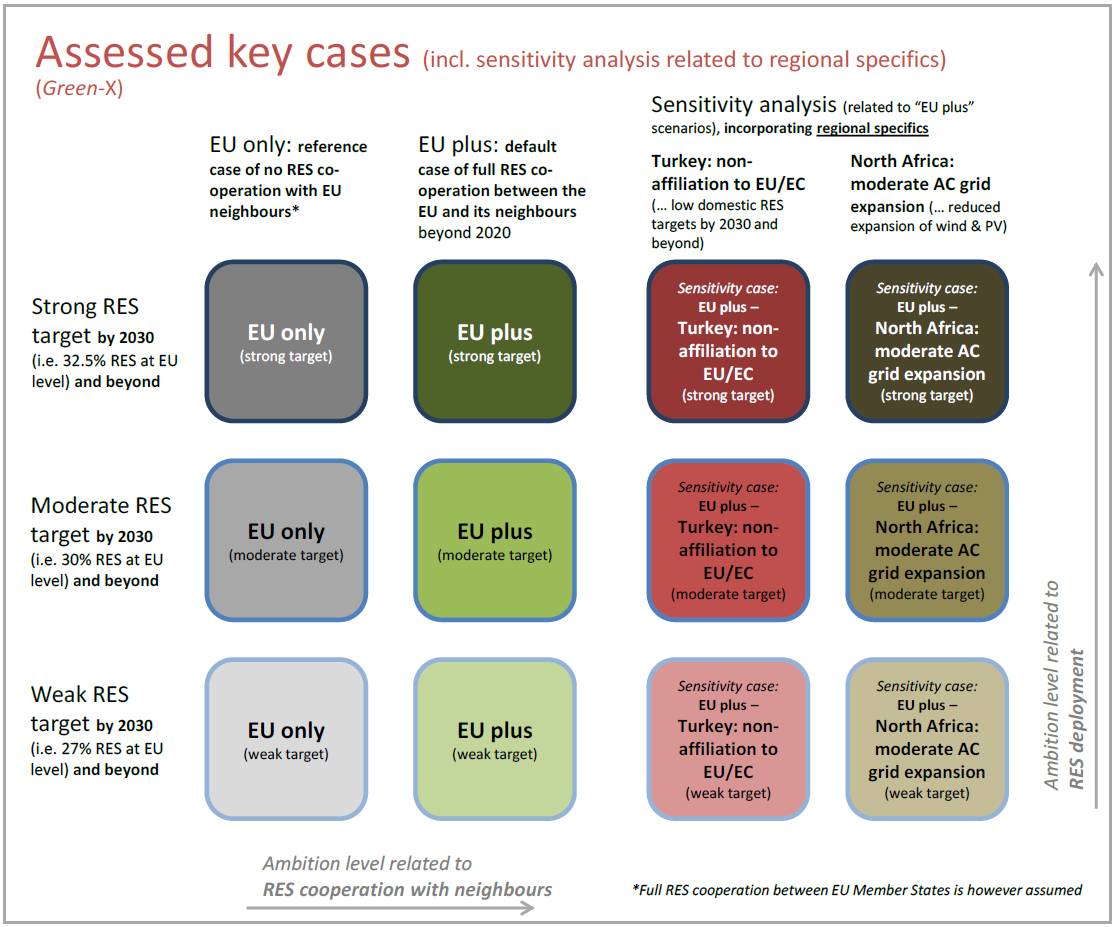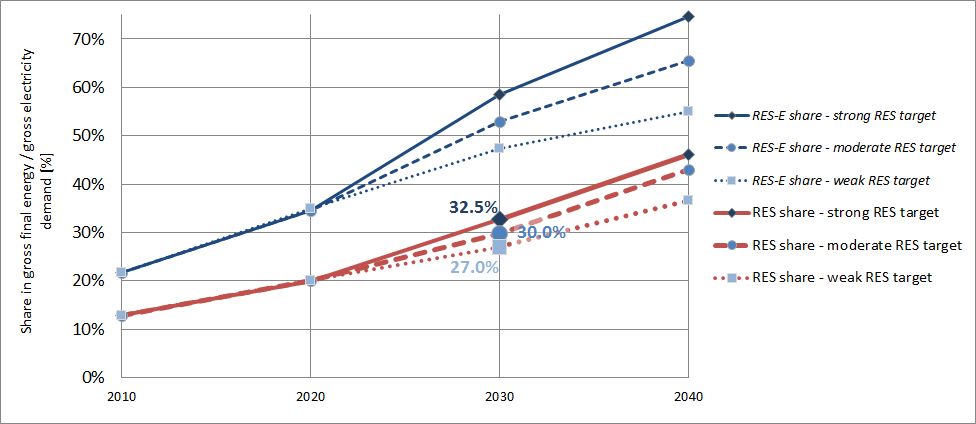
An overview on assessed key scenarios of the integrated assessment is given in Figure 4-1. For this policy-related techno-economic assessment the Green-X model has been applied. Thus, the level of ambition concerning future RES expansion, in particular the envisaged 2030 RES target at EU and Energy Community level, stands in focus of the overall assessment, complemented by sensitivity analyses related to specifics of the targeted regions on their ways forward.
As noted in Figure 4-1 and illustrated graphically in Figure 4-2, for the ambition level related to the future RES expan-sion three distinct RES pathways were assumed for 2030 (and beyond), one following a strong RES target for 2030 (i.e. 32.5% as RES share in gross final energy demand at EU level), one aiming for a moderate 2030 RES target (i.e. 30.0%), and one reflecting the current policy thinking, aiming for a 2030 RES share of 27% (i.e. named subsequently as weak RES target). Then, different policy cases were assessed for achieving these targets, all assuming full RES cooperation within certain system boundaries. The following key scenarios were thus distin-guishable:
- EU only (reference) cases: RES cooperation only within the EU, domestic RES target fulfilment within neighbouring countries.
- EU plus (default cases): these scenarios assume full RES cooperation across the EU as well as all three case regions (North Africa, Western Balkans and Turkey).

Figure 4-1: Overview on assessed key scenarios (key scenarios plus sensitivity cases related to regional specifics)(Green-X (and partly HiREPS) modelling)

Figure 4-2: The assumed ambition level related to future RES deployment by 2030 and beyond at EU level
To fully understand the use of policy instruments and RES targets in this model-based analysis, the following aspects have to be kept in mind:
- Assessment of RES cooperation limited to the electricity sector: The overall modelling of future RES de-velopments in the EU and its neighbours is done for all energy sectors (i.e. electricity, heating & cooling and biofuels in transport) but our detailed assessment of cross-border RES cooperation in the mid- (2030) to long-term (2040) is limited to the electricity sector.
- Quota system with tradable green certificates assumed as common support instrument to better assess prospects for RES cooperation: A (harmonised and uniform) RES-E trading regime is used in modelling to identify the opportunities and benefits related to RES cooperation. More precisely, a support scheme harmonised across all assessed countries is assumed for RES in the electricity sector that does not differentiate between different technologies. In this case the marginal technology to meet the given RES-targets sets the price for the overall portfolio of RES technologies in the electricity sector. The policy costs occurring in the quota system can be calculated as the certificate price multiplied by the RES generation under the quota system. These costs are then distributed in a harmonised way across all countries so that each type of consumer pays the same (virtual) surcharge per unit of (renewable) electricity consumed.
- EU-wide green certificate trading used as reference (EU only cases): First, the EU only (reference) cases are created, in which RES-E trade is assumed to take place among the EU Member States and within the EU boundaries only. Sector-specific targets (for RES-E within the trading regime, and for biofuels in transport where physical trade is common practice already today to meet national blending obligations) and financial incentives for RES in heating and cooling are modified in accordance with the envisaged ambitions level - i.e. until targeted volumes of overall RES deployment (i.e. overall 2030 RES shares in gross final energy demand) are met at EU level.
- Full RES cooperation scenarios assume the establishment of a green certificate trading regime in all as-sessed countries (EU plus Third countries - i.e. EU plus cases): For all further scenarios that include cooperation between the EU and the analysed neighbouring countries, similar RES-E targets to those at EU level (i.e. related to the RES expansion, in particular renewable electricity installations beyond 2020 that are allowed to participate in the RES-E trading regime) are assumed to be applied in the Energy Community (EC), and in particular in our analysed EC Contracting Parties (i.e. the Western Balkans). Virtual exchange is then the default (EU plus) form of cooperation between and within the EU and the EC. In contrast to that, a physical exchange of the produced renewable electricity is conditioned for RES-E cooperation between the EU and North Africa.
- Sensitivity case for Turkey related to the non-affiliation to the EU/EC: For Turkey a sensitivity variant as-sesses the impact of whether accession to the Energy Community or respectively the EU takes place or not - as default the assumption is taken that Turkey will join and consequently apply a similar policy concept and ambition level for RES. In the sensitivity variant of Turkey not joining the assumption is taken that only a low target is followed by Turkey related to its mid- to long-term ambition concerning domestic RES use. This leaves room for further RES-E exports to the EU. In contrast to default (EU plus) within the EU/EC, under these circumstances physical renewable electricity export is then however assumed to be a necessity.
- Sensitivity case for North Africa with respect to a moderate (AC ) grid expansion: A different approach is followed for the North African countries. Domestic RES use is aligned with DLRs bottom-up assessment. Concentrated solar thermal power (CSP) and wind power as well as centralised large-scale photovoltaic (PV) plants not used domestically are then allowed, model wise, to participate in the EU/EC RES trading regime. Within the sensitivity assessment a closer look is taken at the technical concept used to transfer the surplus in renewable electricity from North Africa to Europe. In the sensitivity case DLR’s preferred concept of transferring electricity from CSP via High Voltage Direct Current (HVDC) lines to centres of Europe is followed. This implies consequently a less strong expansion of the conventional transmission and distribution grid in North Africa as well as to Southern Europe, and may therefore lead to a delayed expansion of wind and PV (that appear less viable for HVDC transfer due to their variability).
- Large parts of grid expansion costs borne by RES producers in the case of physical exchange: The complementary power-system analysis gives a rough indication about the infrastructure requirements and corresponding costs to import identified RES electricity volumes to the EU. In Green-X modelling the assumption is taken that large parts of these costs have to be borne by the respective RES producers. In practice that means that in all default scenarios we assume that North African RES producers aiming for the export market (i.e. RES cooperation with the EU/EC) in future years have to cover the largest part of the identified grid expansion costs - as default we estimate that as a rule of thumb two thirds of the identified grid expansion costs are borne by the RES producers whereas the remainder (of one third of the total is socialised).
| <<Back | >>Back to Introduction<< | Next>> |